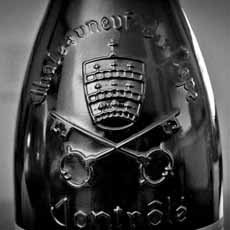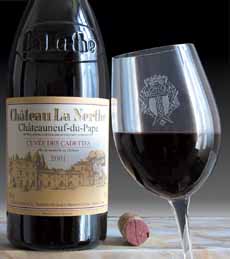WINE: Châteauneuf-du-Pape, A Great Red Wine From Provence
|
A few weeks ago, we received a pitch promoting particular wines for International Châteauneuf du Pape day, held on the third Friday in September (today). It inspired us to write about the wine, one of our favorite reds. In France, wines are named after their communes (think village or county), departments (think state) or regions. The village of Châteauneuf-du-Pape lies in the Southern Rhone, north of the city of Avignon. Châteauneuf-du-Pape (pronounced pop) isn’t a wine common to American wine lists these days. It’s pretty pricey, with top bottles going for $100 more at retail, before the restaurant mark-up. But in our youth, when even the best wines were more or less affordable, Châteauneuf-du-Pape was a staple at top steakhouses. If you could afford the steak, you could afford the wine. Châteauneuf-du-Pape is the largest and most important wine appellation in the southern Rhône. Ninety-five percent of the wines are red, with rich red-fruit aromas, strong fruit flavors and plenty of spice and high alcohol (14%). The best wines may also exhibit notes of garrigue, a term for the herby aroma of the Proveçal underbrush. A small amount of white wine is produced, but it is typically consumed locally. Regulations do not allow the production of rosé wine [source]. There’s a 14th-century medieval castle in ruins at the top of the hill, but the town isn’t named for the castle. Rather, the first mention of the village is in a Latin document from 1094 that uses the name Castro Novo, referring to a new village. At that time castro, or château in French, was used to denote a fortified village, rather than the mansion it later came to denote. In 1309s, Pope Clement V, the “pape” in Châteauneuf du Pape, moved the papacy to Avignon. A total of seven popes resided for the next 67 years. He and subsequent popes loved the local wine, and encouraged more viticultural in the area. As a result, almost all of the cultivable land is planted with grape vines. By the 16th century, the village was officially called Châteauneuf du Pape. The Châteauneuf-du-Pape appellation is an A.O.C.* (appelation origine contrôlée), meaning that by law it can only be produced locally, from specific grapes grown in the commune of Châteauneuf-du-Pape and in portions of four adjoining communes. Almost all wines from the Southern Rhône are blends. Châteauneuf-du-Pape is no different. Grenache is the most widely planted grape, but by law 18 grapes† are allowed in the blend. Winemakers use different grape selections and percentages based on what they are trying to achieve. Grenache is followed by Mourvèdre, Syrah and Cinsault. And yes, some vintners use all 18 grapes, and a few use 100% grenache. A popular blending template is known as GSM: Grenache, Syrah and Mourvèdre. Consult with your wine store clerk about the options at hand, and their peak drinking times (some are ready to drink now, some aren’t). What you need to be aware of is that there are three tiers of price/quality: —Kris Prasad |
|
|
|
________________ *A.O.C., an abbreviation of appellation d’origine contrôlée, is a legal designation that places rigid standards on how and where a French product can be produced. This ensures consistent quality and preserves its reputation, and distinguishes an authentic product (e.g., Parmigiano Reggiano) from a generic one (e.g. parmesan cheese). †The grapes, in order of use are Grenache, Syrah, Mourvèdre, Cinsault, Clairette, Grenache Blanc, Bourboulenc, Roussanne, Counoise, Muscardin, Vaccarese, Picpoul Picardan, and Terret Noir. Very recently, additional varieties have been added by law for a total of 18 varieties.
|
||







